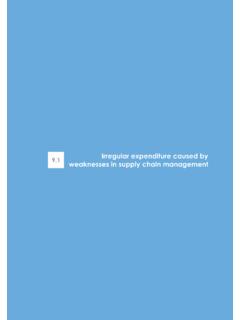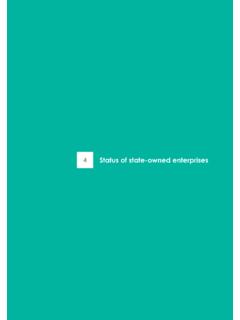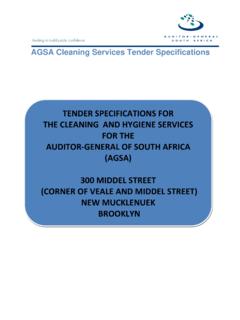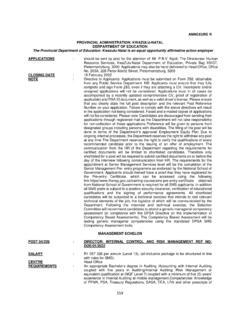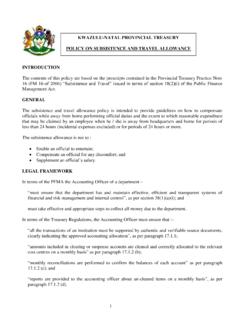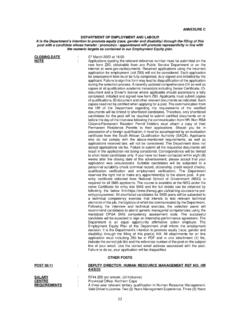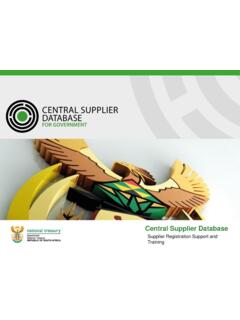Transcription of Irregular expenditure caused by 9 - AGSA
1 Irregular expenditure caused by 93. weaknesses in supply chain management General report on the national and provincial audit outcomes for 2016-17. Irregular expenditure caused by weaknesses in supply chain management What is Irregular expenditure ? Irregular expenditure is expenditure that was not incurred in the manner prescribed by legislation; in other words, somewhere in the process that led to the expenditure , the auditee did not comply with the applicable legislation. Such expenditure does not necessarily mean that money had been wasted or that fraud had been committed. It is an indicator of non-compliance in the process that needs to be investigated by management to determine whether it was an unintended error, negligence or done with the intention to work against the requirements of legislation.
2 Such legislation requires, for example, that procurement should be fair, equitable, transparent, competitive and cost-effective. Through such investigation, it is also determined who is responsible for the non-compliance and what its impact was. Based on the investigation, the next steps are determined. One of the steps can be condonement if the non-compliance had no impact and negligence was not proven. Alternatively, if negligence was proven, the steps can be disciplinary action, recovery of any losses from the implicated officials or even cancelling a contract or reporting it to the police or an investigating authority. The PFMA is clear that accounting officers and authorities are responsible for preventing Irregular expenditure .
3 It also stipulates the process to be followed when it does occur, as described above. In order to promote transparency and accountability, auditees must disclose all Irregular 94 expenditure identified (whether by the auditee or through the audit process) in their financial statements together with details on how it was resolved; in other words, how much was investigated, recovered or condoned. Status of Irregular expenditure Figure 1 shows the four-year trend in Irregular expenditure based on the amounts disclosed in the financial statements of auditees. It also indicates the percentage of Irregular expenditure identified by auditees versus that identified by the audit process as well as the proportion of Irregular expenditure disclosed that had been incurred in previous years (blue line).
4 General report on the national and provincial audit outcomes for 2016-17. Figure 1: Four-year trend in Irregular expenditure (excludes outstanding audits, such as that of Prasa). As can be seen in figure 1, Irregular expenditure had increased by 55% (R16 183 million) from the previous year and by 53% (R15 739 million) from 2013-14. The number of auditees incurring such expenditure had increased to 265. A total of 229 (86%) of these 265 auditees had also incurred Irregular expenditure in the previous year, of which 177 (67%) had incurred such expenditure for the past four 95. years. The total Irregular expenditure incurred over the past four years was R128 billion. The total Irregular expenditure for 2016-17 is even higher than the R45 596 million shown in figure 1, as the Irregular expenditure disclosed by auditees whose audits had been completed before the date of this report (but was not included in the analysis) was R1 091 million.
5 The auditees of which the audits had not been completed also typically incur high Irregular expenditure ; for example, Prasa disclosed Irregular expenditure of R13 971 million in 2015-16. Section provides more information on these outstanding audits. Auditees in KwaZulu- natal , the Free State, Limpopo and the Eastern Cape were the main contributors to the significant increase in Irregular expenditure from the previous year as indicated below: KwaZulu- natal R7 781 million (increased by 218%) (also had the highest amount of Irregular expenditure in 2016-17). Free State R3 494 million (increased by 181%). Limpopo R1 545 million (increased by 150%). Eastern Cape R1 136 million (increased by 92%). The sectors with the highest amounts of Irregular expenditure were health (R11 777 million), transport (R6 378 million) and education (R6 090 million).
6 Figure 1 further shows that 64% of the Irregular expenditure was as a result of non-compliance in the current year, but that 36% was the result of acts of non-compliance in previous years. This is typically due to one of the following scenarios: 1. Payments were made in the current year on a contract that had been irregularly awarded in a previous year if the non-compliance was not investigated and condoned, the payments on these multi-year contracts will continue to be viewed and disclosed as Irregular expenditure . General report on the national and provincial audit outcomes for 2016-17. 2. Non-compliance in previous years was only identified in the current year and all the related expenditure (even from the previous years) was disclosed in the current year.
7 If we determine that an auditee did not fully disclose all of its Irregular expenditure in the financial statements, the disclosure is qualified if material. To address such a qualification, auditees typically do a very detailed review of their processes in previous years to identify all the Irregular expenditure and correctly disclose it as per scenario 1 above. In total, R7 562 million (2015-16: R546 million) of the Irregular expenditure as shown in figure 1 was as a result of auditees fully recognising their previous years' irregularities to address these qualifications. It is encouraging that the full disclosure of Irregular expenditure is being addressed, as it improves transparency and accountability. As detailed earlier on in this section, inadequate action taken by accounting officers and authorities to prevent Irregular expenditure was one of the most common material findings on compliance.
8 We reported the findings on compliance as material at 89 departments (54%) (2015-16: 86 [52%]) and 60 public entities (26%) (2015-16: 65 [32%]), based on the fact that they incurred Irregular expenditure in 2016-17 and the previous year, a recurrence of the transgressions that had caused such expenditure , and our assessment that adequate controls and processes would have prevented it. Figure 1 also shows that we had identified 22% of the Irregular expenditure of 2016-17 during the audit process (a slight improvement from the previous year), which means that some auditees did not have adequate processes to detect and quantify all Irregular expenditure . Completeness of Irregular expenditure In 2016-17, 98 auditees (25%) disclosed in their financial statements that they had incurred Irregular expenditure , but the full amount was not known as it was still being investigated.
9 In 2015-16, 88 auditees (24%) had made this disclosure. A total of 28 auditees (7%) (2015-16: 29 [8%]) were qualified on the completeness of the disclosure of Irregular expenditure in their financial statements, both in 2016-17 and 2015-16. 96 This means that the amount of Irregular expenditure for 2016-17 could have been higher if the full amounts had been known and disclosed. What caused these high levels of Irregular expenditure ? As part of our audits of SCM in 2016-17, we tested 5 816 contracts (with an approximate value of R119 828 million) and 14 261 quotations (with an approximate value of R2 832 million), referred to as awards' in the rest of this report. Refer to section 17 for a description of the scope of our SCM audits.
10 Although not all non-compliance with SCM legislation results in Irregular expenditure , the high occurrence of Irregular expenditure usually correlates with poor SCM practices. There were slightly more auditees with SCM findings (282) than Irregular expenditure in 2016-17, as typically SCM findings such as inadequate measures to monitor the performance of contractors would not result in Irregular expenditure . In total, R40 434 million (89%) (2015-16: 89%, R26 079 million) of the Irregular expenditure in 2016-17 was as a result of non-compliance with SCM legislation. The following were the main areas of SCM non-compliance as disclosed by the auditees in their financial statements, with an indication of the estimated value of such expenditure : Procurement without a competitive bidding or quotation process R14 958 million (37%).
